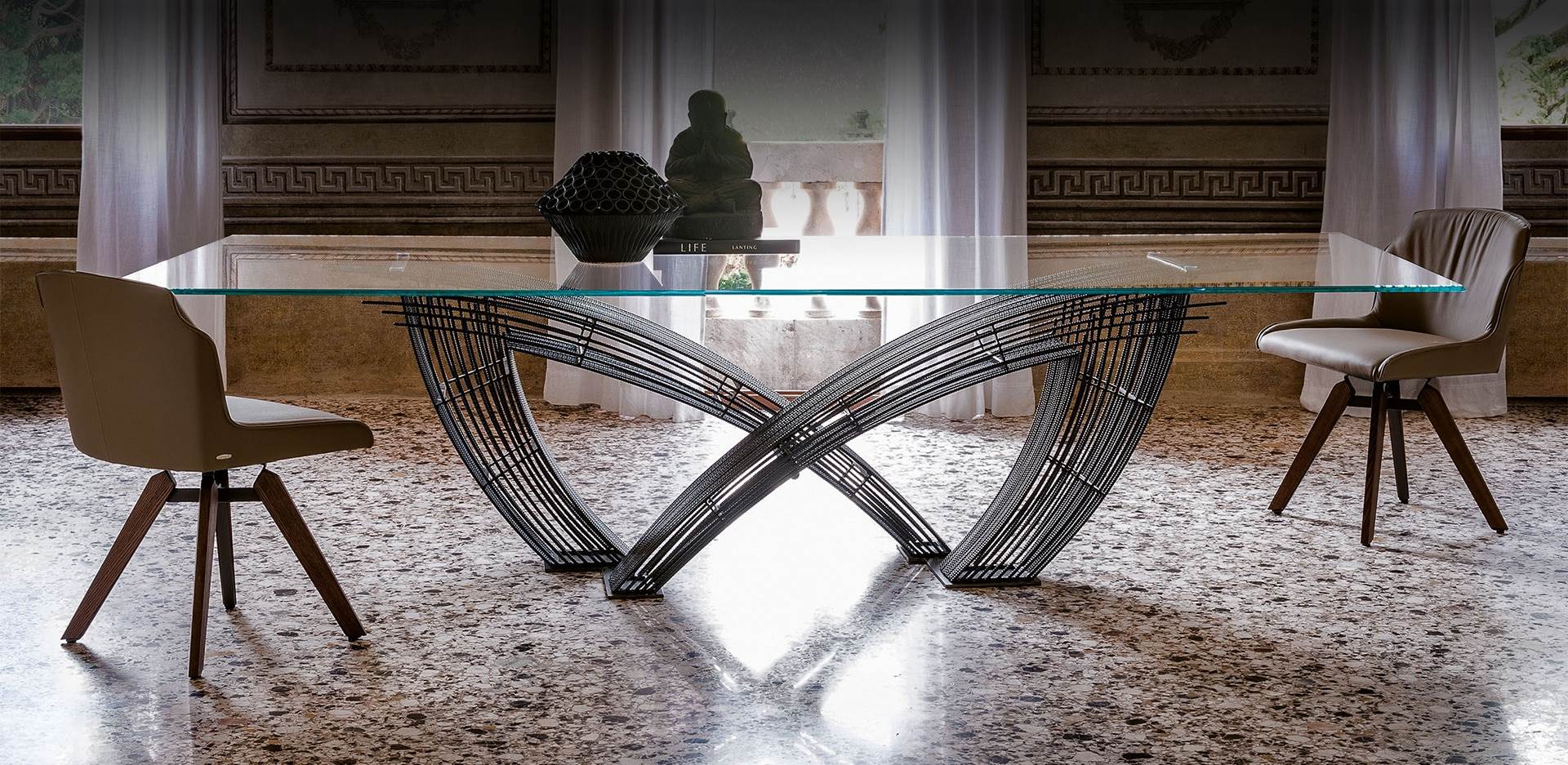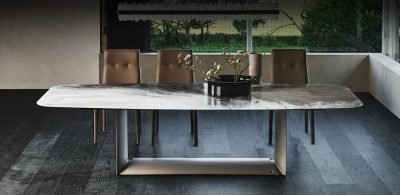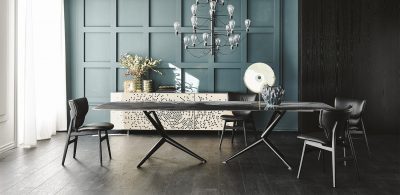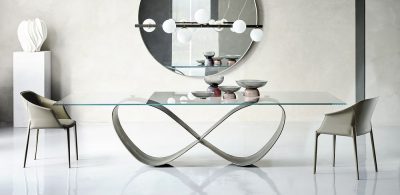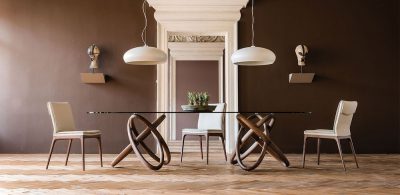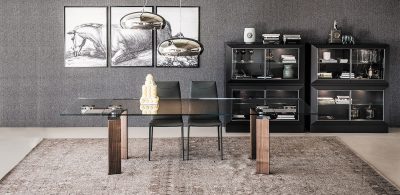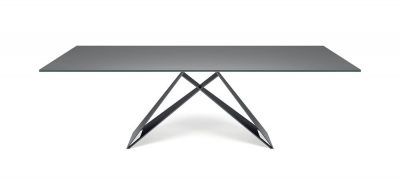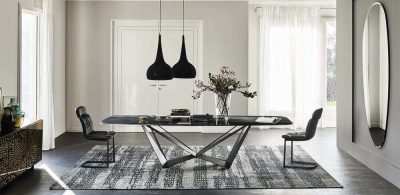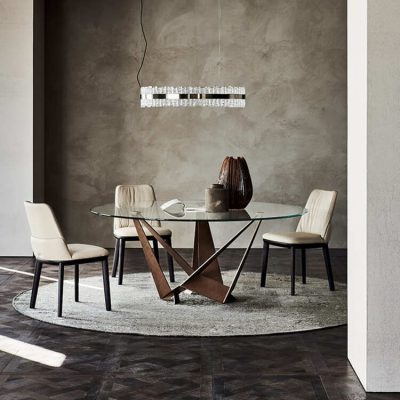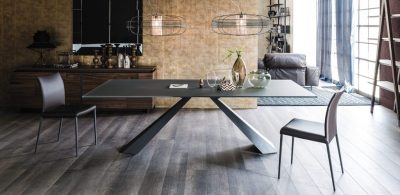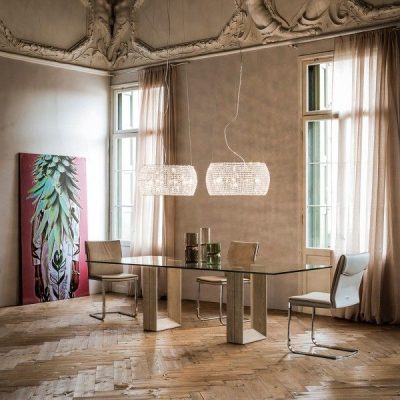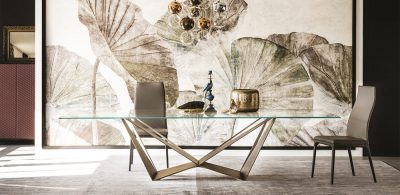Glass tables
Discover our collection of luxury coffee and dining tables with glass table tops.
Featuring high-end design and unmatched quality, our tables with glass tops will undoubtedly captivate you.
Crafted by internationally renowned manufacturers, you can be assured of acquiring a dining table from the finest European houses, offering original and authentic design.
Allow yourself to be surprised every day with a high-end glass dining table that combines design, quality, durability, and functionality.
The choice of true and absolute luxury awaits you; discover our glass table models below.
Showing all 19 results
-
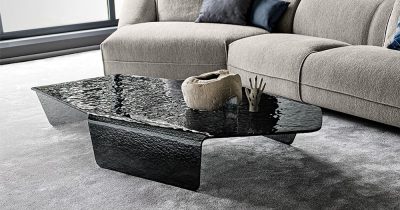 Select options This product has multiple variants. The options may be chosen on the product page
Select options This product has multiple variants. The options may be chosen on the product pageChimera glass table
1.510 € – 6.535 €The elegance of the illusion. Bring a modern touch to your interior thanks to the Chimera modern glass coffee table.
-
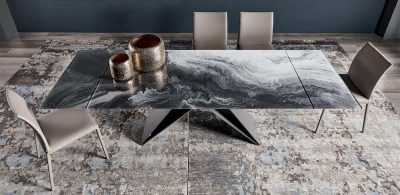 Select options This product has multiple variants. The options may be chosen on the product page
Select options This product has multiple variants. The options may be chosen on the product pageCrystalart drive table Premier
5.815 € – 7.165 €This high-end glass dining table is the perfect solution for those who like to surround themselves with luxury.
Its unique glass top design gives it a touch of originality and elegance.
It is versatile and you can adapt its size according to the number of guests you wish to seat.
-
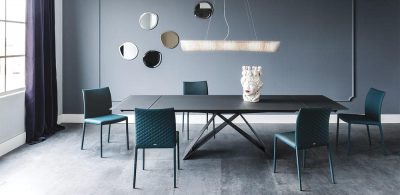 Select options This product has multiple variants. The options may be chosen on the product page
Select options This product has multiple variants. The options may be chosen on the product pageDrive table Premier
5.160 € – 6.150 €The modern dining table refers to the idea of high-end furnishing.
With its glass top, this elegantly designed table will become the centerpiece of your space.
With its extendable option you have the possibility to adapt it to the size of your room and the number of your guests.
The harmonious design of the table leg reflects the modernity of this masterpiece.
-
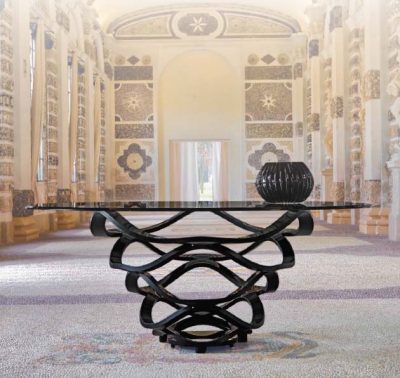 Select options This product has multiple variants. The options may be chosen on the product page
Select options This product has multiple variants. The options may be chosen on the product pageNeolitico luxury designer glass table
10.645 € – 12.040 €The exceptional design of this table is a creation by Tulczinsky. A model of this table is permanently exhibited at the Palazzo del Quirinale in Rome, Italy.
This version of a dining table with a curved glass base is a true gem reflecting an ultra-contemporary design combined with the expertise of an Italian manufacturer renowned in the field of luxury artistic glassware.
-
 Select options This product has multiple variants. The options may be chosen on the product page
Select options This product has multiple variants. The options may be chosen on the product pageSan Marco table in Murano glass
154.000 € – 225.000 €The San Marco exemplifies the exceptional quality and unmatched artistry of the centuries-old glass-making tradition from Murano, a Venetian island renowned for its craft.
Design by Riccardo and Luciano Lucatello.
Each creation is a genuine piece of art, meticulously shaped in a specialized furnace heated to 1500 degrees Celsius, as demonstrated in the video below.
Offered in two sizes, the largest measures 455 cm in length, making it a distinctive masterpiece suited for the most esteemed locations globally.
The hand-crafted glass legs can be illuminated with LED lights to create an even more stunning setting.
-
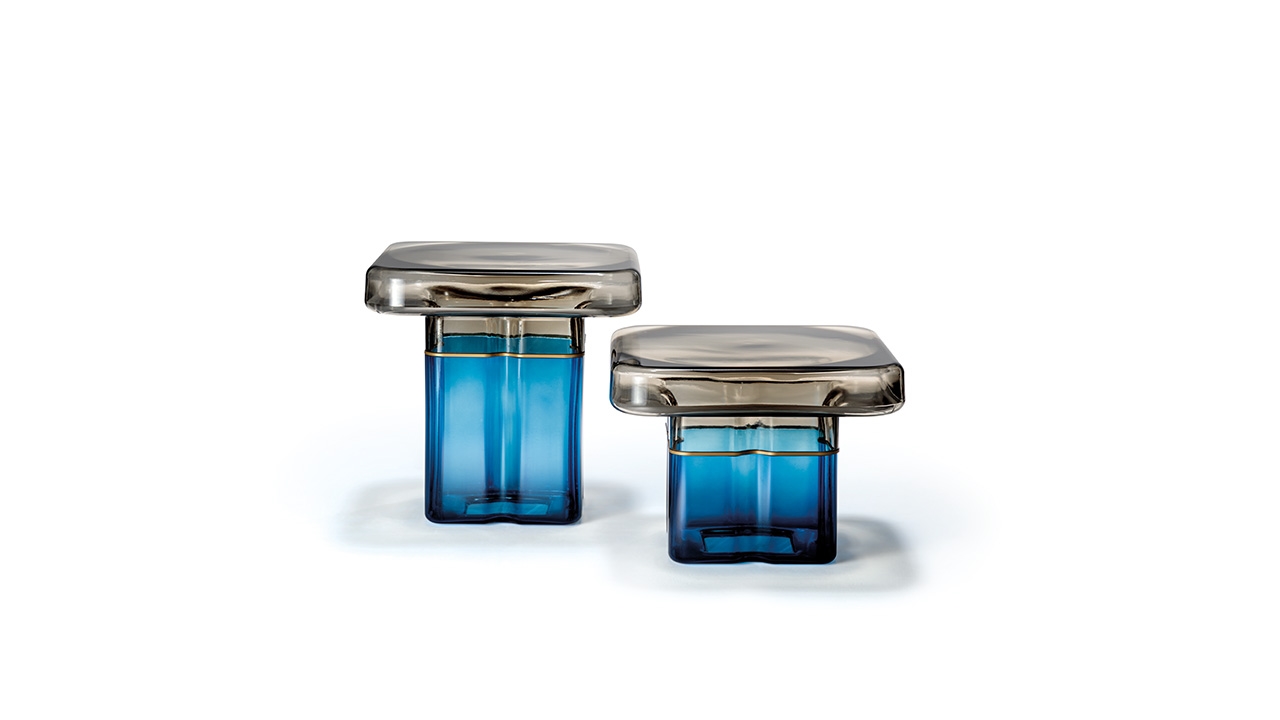 Select options This product has multiple variants. The options may be chosen on the product page
Select options This product has multiple variants. The options may be chosen on the product pageTau Murano glass coffee table by Tulczinsky
2.100 € – 2.250 €Murano glass coffee tables featuring a metallic insert.
This magnificent creation by Tulczinsky and exquisitely produced by the prestigious Italian luxury furniture manufacturer REFLEX has been meticulously handcrafted in Murano by master artisans skilled in the ancient art of glassblowing.
The Tau Murano is a compact, two-tone coffee table meticulously crafted using age-old Venetian glassblowing methods. Its unique and sophisticated design features two blown glass components connected by a refined metal frame. Straddling the line between a functional coffee table and an ornamental piece, it infuses any space with a sense of lightness and radiance.
-
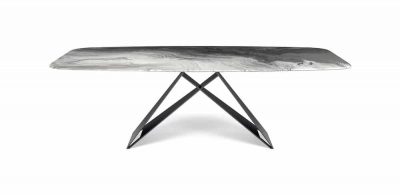 Select options This product has multiple variants. The options may be chosen on the product page
Select options This product has multiple variants. The options may be chosen on the product pageCrystalart table Premier
4.770 € – 6.925 €This luxury crystalart dining table will be the masterpiece of your dining room.
Its contemporary and luxurious design will match perfectly to your design needs.
The crystalart top and the metal base give more elegance to this beautiful italian design high-end dining table .
-
Select options This product has multiple variants. The options may be chosen on the product page
Dragon crystalart table
4.990 € – 7.030 €The Dragon crystalart furniture piece is a large, original and artistic dining table. Perfect to host until 12 guests.
-
Select options This product has multiple variants. The options may be chosen on the product page
Atlantis cristalart Table
5.285 € – 6.585 €This modern luxury table is a symbole of elegance. Do not hesitate to discover our range of aesthetic high-end table.
-
Select options This product has multiple variants. The options may be chosen on the product page
Butterfly table
5.090 € – 7.920 €The Butterfly designer glass table will perfectly fit to wide and refined spaces thanks to its curves and high quality material. This masterpiece is designed by nucleo+.
-
Select options This product has multiple variants. The options may be chosen on the product page
Carioca wooden and glass table
5.505 € – 12.465 €Are you looking for a stunning glass and wood table ? The Italian design of this refined and elegant table will captivate you ! You have an unique personality, opt for a glass and wood table that reflects your image.
-
Select options This product has multiple variants. The options may be chosen on the product page
Daytona table
6.395 € – 8.665 €Did you ever thought it was possible for a glass table to be expandable ? Now it is possible with the Daytona original extensible table !
If you are simply looking for an original extensible table ? The Daytona expandable modern dining table will delight those who need functionality and modernity.
-
Select options This product has multiple variants. The options may be chosen on the product page
Table Premier
3.300 € – 3.960 €The Premier high-end modern dining table is a perfect match for luxury furnishing solutions.
With its distinctive Italian design, the contemporary aesthetic of this table exalts its success.
Its glass top honors the conviviality even if the spaces are small.
The base’s originality of this modern luxury furniture makes it even more elegant. -
Select options This product has multiple variants. The options may be chosen on the product page
Crystalart table Skorpio
4.665 € – 7.925 €This wonderful contemporary design table has become an icon in the dining room. The designer of this product has known how to evolve with the trends.
The use of a Crystalart table top brings out its touch of personality. -
Select options This product has multiple variants. The options may be chosen on the product page
Round table Skorpio
3.135 € – 6.635 €As luxurious in glass as it is in wood, this luxury round table will illuminate your room with beauty.
With its unusual base, this quality design table will bridge the gap between the high end and the originality.
You won’t need to search for luxury in luxurious places anymore, surrounding yourself with this table will give you that feeling at home. -
Select options This product has multiple variants. The options may be chosen on the product page
Eliot table
2.725 € – 6.990 €Marble furniture may look imposing in more traditional designs but not in the case of this elegant designer table. The slim table top’s lightness and well as its rounded edges’ softness make this luxurious marble table seem graceful and weightless.
-
Select options This product has multiple variants. The options may be chosen on the product page
Diapason marble table
3.490 € – 4.510 €If you think marble table is definitely not discreet, check out the Diapason table. This luxury marble table features a glass top and a beautiful marble base. This high-end furniture designed by the studio Diapason will sublimate your space with a very elegant touch.
-
Select options This product has multiple variants. The options may be chosen on the product page
Glass table Skorpio
2.550 € – 7.070 €This Skorpio design dining room table perfectly connects the idea of luxury and modernity.
Its contemporary and elegant design will highlight the room dedicated to it.
The splendid table stand with harmonious geometry offers you magical folds that make it an exceptional luxury design table.
This video shows the making of one of our Murano glass tables, a true work of art and, logically, one of the most expensive tables in the world. Watch the video and you will easily understand why the price of this table is so high.
Contents
- Why choose a designer glass table?
- What are the different shapes of a glass table?
- What are the advantages of a glass table?
- What are the disadvantages of a glass table?
- How to choose your glass dining table?
- What shape for your glass table?
- What size for your glass table?
- How much does a glass top weigh?
- What thickness should the glass top of your table be?
- What base for your glass table?
- What design for your glass table?
- How much does your high-end glass table cost?
- Quality, manufacturer reputation
- What other styles of furniture will fit in the same space as your glass table?
- Choosing between a glass table and a crystal table, what’s the difference?
- What are the different types of glass?
Why choose a designer glass table?
Choosing glass over another material (wood, metal, ceramic, marble, etc.) for your dining table or coffee table is an informed choice in every sense of the word.
Technological advances combined with ancestral techniques of master glassmakers allow to obtain astonishing results. If we add the creativity of a world-leading furniture designer, your glass table could be a work of art in terms of execution and aesthetics.
Our manufacturing partners draw on the talent passed down from generation to generation among the master glass artisans of Murano, a region renowned for its Murano glass and crystal creations.
Science and new technologies have allowed bold techniques to expand the possibilities of glass table designers. Crystalart allows to print beautiful patterns on a glass surface, the result is a unique glass design table.
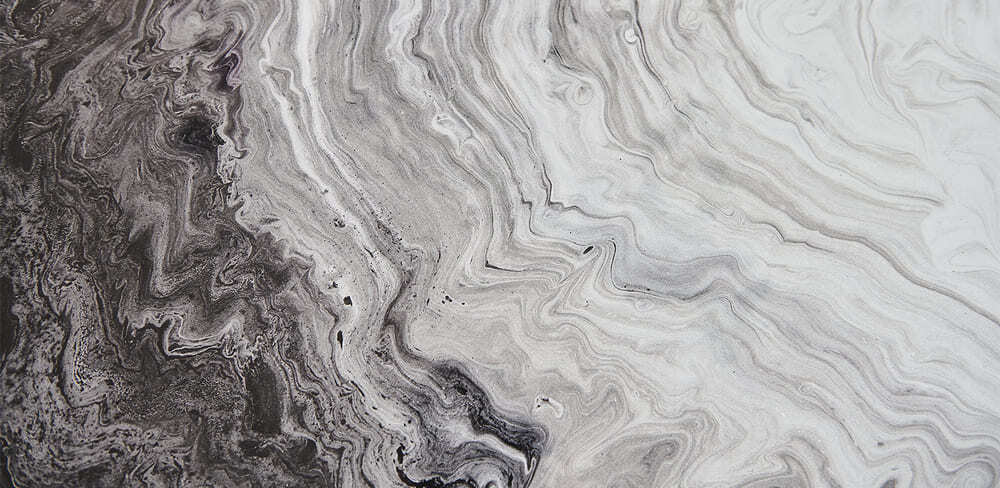
Skorpio crystalart modern dining table (printed glass top view)
What are the different shapes of a glass table?
Round glass table
This shape is more complex to achieve than a glass table with right angles, the possibilities of having a round glass table with large dimensions (a large diameter) are increasingly important. The advantages in terms of user-friendliness are certain, it is also necessary to weigh the technical constraints (maximum diameter available) and logistical constraints (cost of protection in technical packaging).
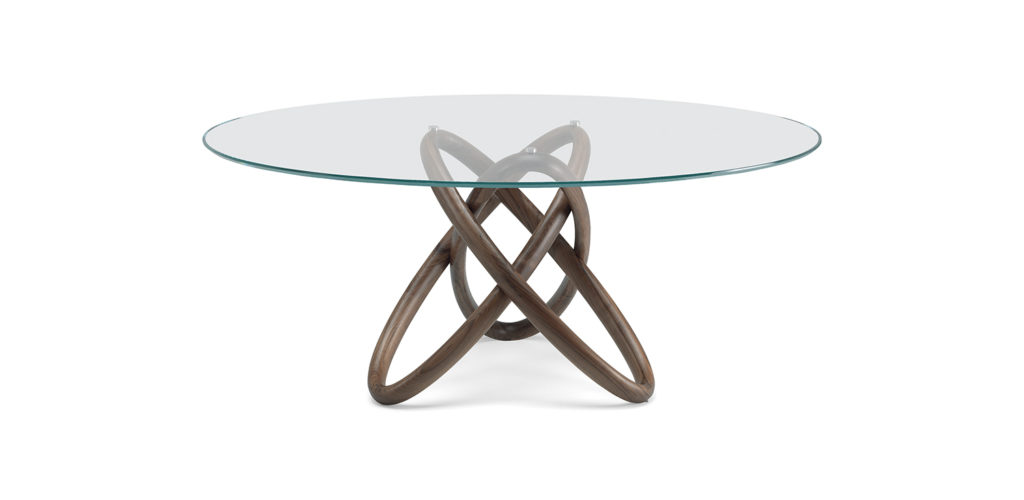
Square glass table
It is also possible to make square tables with increasingly larger dimensions thanks to technological advances as well as progress in packaging and conditioning techniques for these fragile pieces of furniture during transport.

Rectangular glass table
The most requested glass table shape is undoubtedly the rectangle. It is also at the level of the legs of a rectangular top that we can find the results of the latest technological advances. The legs (base, base, etc.) are made of different and varied materials, with increasingly daring aesthetic effects.
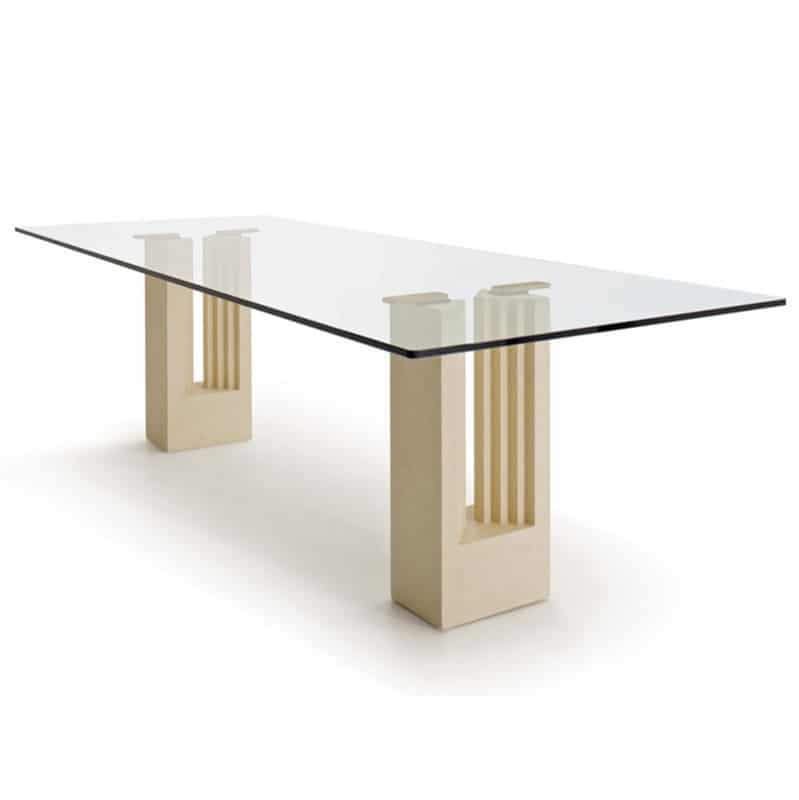
Oblong glass table (barrel shape)
The oblong (barrel) shape of a glass top is increasingly requested by our customers. It helps to soften the angular appearance of square and rectangular tables.
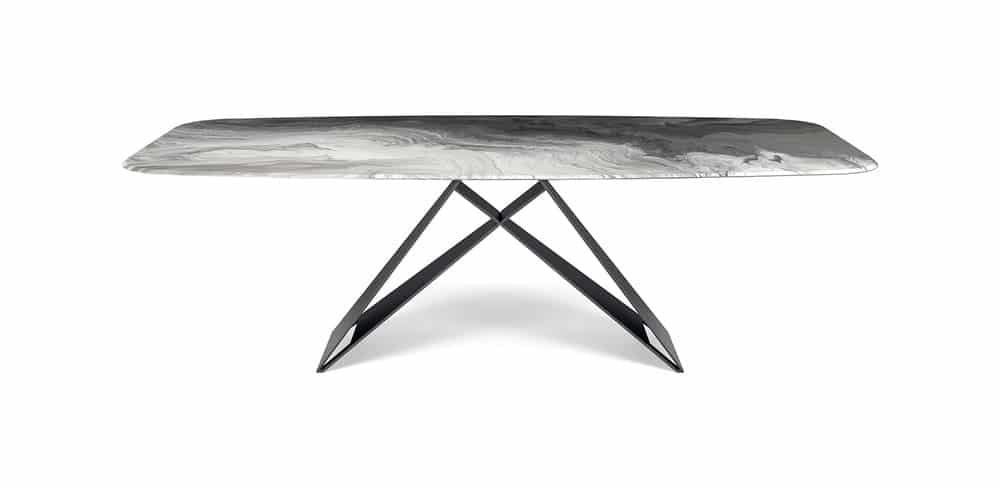
Glass table with beveled edges
This refers to the appearance of the edge of the table top, regardless of the shape of the glass top.
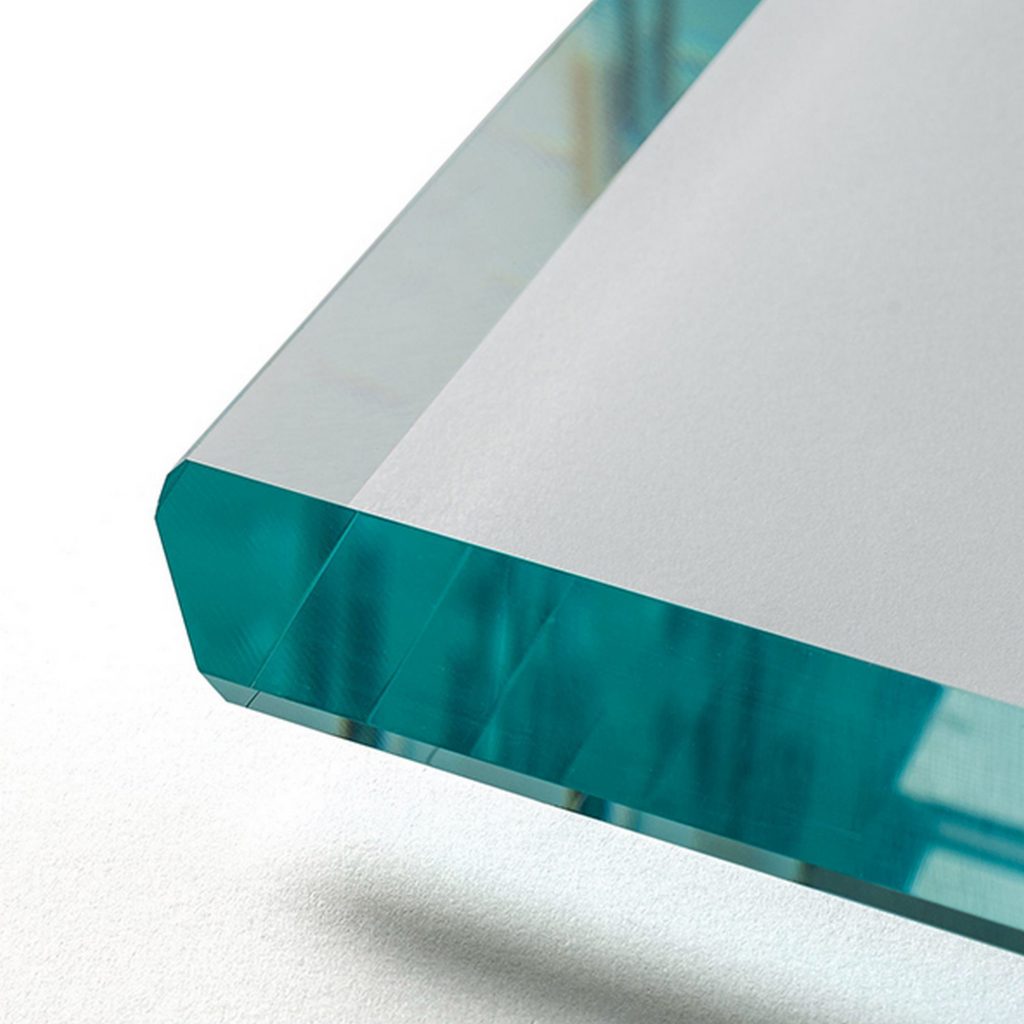
Glass table with extensions
Previously unthinkable, the glass table with extensions is now available in multiple offers on the internet. Of course, do not confuse a real high-end glass table with one that is not. A difference in weight is found in the components and elements allowing the extensions to be deployed.
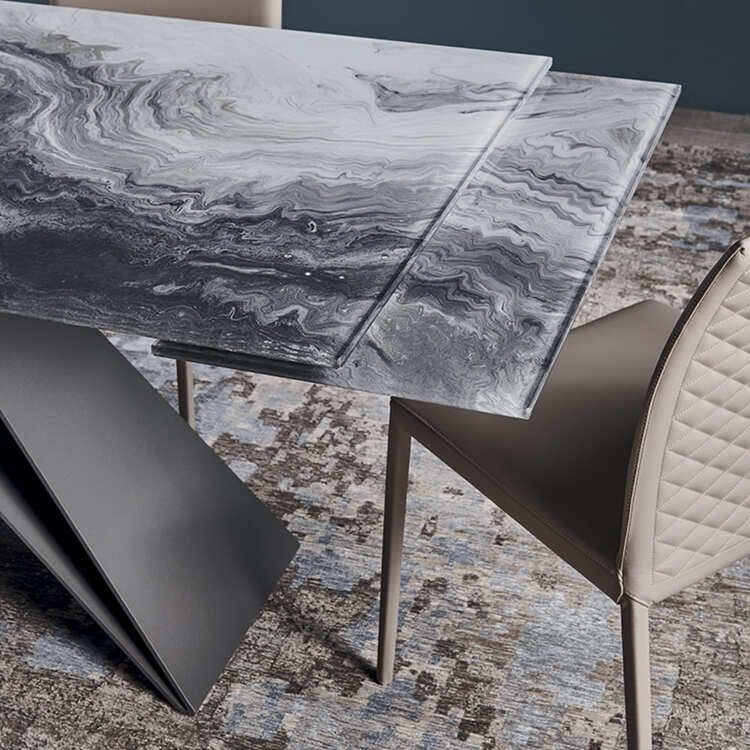
What are the advantages of a glass table?
1) The increased possibilities of a constantly evolving contemporary design
The shapes and functions of a glass table continue to evolve with technological advances. Strength, safety, durability are all properties that have been reinforced with the advancement of science and production methods. The structural and technical possibilities of glass now available to glass table creators and designers allow them to give free rein to their creativity. The result is a new generation of luxury glass tables.

The main advantage of a glass table is that it lets the furniture and decorative accessories around it shine. This does not mean that your glass table will lack presence or identity in the layout of your space. It is quite easy to match a glass table with the furniture already present in your home. Its minimalist, elegant and thin silhouette allows a perspective view that crosses the entire room, clear, simple and clean without the perception of abrupt angles.
Glass being a sober and elegant material at the same time, it translates into a multiplicity of furniture design styles (from classic to hyper-contemporary). The use of glass is found in a growing number of furniture categories: dining tables, coffee tables, side tables, bedside tables, consoles, sideboards, chests of drawers, shelves, etc.
2) Brightness and feeling of space
A glass surface is generally transparent, which allows you to visually enlarge your living room or dining room by lightening it and reducing the feeling of clutter that an opaque or non-transparent table top can produce. Whether it is a coffee table or a dining table, you will benefit from the visual lightness as well as the reflection of light that a glass top provides. The other contrasts visible in the room will be perfectly visible through a glass table top.
3) Stain resistance and hygiene
The properties of glass allow you to count on a dining table whose top will be dense and non-porous. It will not be affected by humidity and will not deform unlike, for example, wood which can gradually become waterlogged.
4) Glass, a resistant material contrary to appearances
The mechanical properties of glass are excellent: a beautiful shine thanks to its reflection, a silky and pleasant touch, heat resistance up to 600 degrees, non-flammability, corrosion resistance, etc.
Tempered glass dining tables, available in various colors, patterns and shapes to meet the different needs of consumers, are more resistant furniture than you might think. Of course, pay special attention to the thickness and origin of manufacture of the top of your glass table, these parameters are vital for the durability and robustness over time of your table.
5) Ease of cleaning and maintenance
With simple gestures like using a soft cloth and a little warm water (or alcohol), you can keep your glass table in good condition for hundreds of years. Avoid at all costs abrasive cloths or materials that can permanently damage your glass table. We advise you to do regular maintenance and cleaning of a glass table to make it last longer.
How to remove scratches from glass table?
To remedy light scratches on your glass table, you have several options:
Toothpaste
Apply toothpaste to the scratches, making sure to work it into the cracks. Once the toothpaste is dry, take a cloth and rub the scratched areas well. Then spray it with window cleaner and wipe it with a clean, soft cloth.
The White of Meudon
This powder comes from the stone quarries of Meudon, near Paris. Sprinkle a quantity on the scratched glass surface, rubbing vigorously on the affected areas. Finally, rub with a cloth soaked in elbow grease 😀.
What are the disadvantages of a glass table?
1) A glass table is incompatible with the principles of Feng Shui
Feng Shui is a thousand-year-old art of Chinese origin that seeks to establish harmony among the different energies present in a place in order to promote the well-being, health and prosperity of its occupants. In China, it is generally called the discipline fēng shuǐ xué. Furniture has a crucial impact on the energy of a room through its shapes, colors, materials used, layout, etc.
The Chinese and other Feng Shui practitioners prefer wooden table tops over any other material for its stability and strength properties. Wood is also preferred as a material because it is “soft” and has a “warm” texture. The energy of wood invites sharing thanks to its warm properties and welcoming image.
Stone, although considered a “hard” material by Feng Shui, has an energy that refers to the natural and warm properties of the “earth” element. This material is therefore also suitable for a dining table. The earth element to which stone refers brings a feeling of stability and security to the dining room.
Glass is a material that is considered “hard” and “cold” by Feng Shui. According to Feng Shui precepts, glass is considered a fragile material that can be easily broken. The belief is that when you and your guests sit down to eat around a dining room table, the glass tabletop creates feelings of anxiety, nervousness, and sensitivity that can affect table relationships as well as your health.
According to Feng Shui, you would be more concerned about the glass table top while eating than focusing and enjoying your meal.
If you must have glass in the dining room, bring in a mirror or two. Mount them high on the wall where they can reflect the glass table top, and the mirrors will make the room feel more open. To balance and offset the presence of glass in your dining room, use a natural material like wood for the mirror frame.
2) A glass table is fragile when faced with shocks and scratches.
This is a definite weak point compared to other more solid materials such as marble, stone or wood: shocks and scratches.
3) Visible dust and fingerprints
The transparency and shine of a glass table make fingerprints and other dust residues much more visible. Just wipe the surface with a soft cloth, even if dry, and the dust will disappear quickly.
4) The cost of tempered glass
A glass table top must be made of tempered glass to reduce the risk of injury in the event of breakage.
Producing tempered glass involves considerable energy consumption due to the additional heat treatment compared to other types of glass. The impact on its price is considerable given energy prices and the upward trend in recent years. First, COVID (impact on existing glass stocks) and the European geopolitical situation since March 2022 have had negative impacts that have contributed to pushing the price of glass upwards.
As of March 17, 2021 alone, we were at more than 30% increase in the price of glass since June 2020. This translated into an automatic increase in the prices of glass tables.
Unlike other materials, such as steel and oil, which are listed and whose quotations are visible, there is no official quotation for the price of glass. But it is experiencing the same upward trend as other raw materials.
5) Transporting a glass table
Apart from the general cost of transport (whatever the composition of your table) which continues to increase, the fragility of a glass table during transport requires the use of specific packaging and conditioning, which is more expensive than “traditional” packaging.
It is appropriate to raise awareness among teams transporting a glass table so that they take this into account when handling packages.
6) Children and animals
A glass table is not recommended for a family with small children or pets. Every year, emergency rooms receive an increasing number of children injured by glass tables.
The type and quality of glass you use for your table will determine its safety. It is important to make sure you get a tempered glass top rather than traditional glass which shatters into multiple pieces of glass that are jagged and large.
In all cases, care should be taken to have rounded corners and not right angles which could injure children.
How to choose your glass dining table?
Once you’ve determined that a glass top table is what you need, you’ll find yourself faced with an avalanche of products and retailers.
There are several criteria that should guide you in your search for the table that suits you best. We invite you to check each of these parameters before purchasing your glass table.
What shape for your glass table?
Round, square, rectangular, oval and oblong are the most common shapes. Think about the number of guests (regular and occasional), the atmosphere you want to create and the layout of your dining room.
A round or square table encourages interaction between guests because everyone can see and interact easily with the other guests. A rectangular table distances guests at opposite ends of the table.
The big advantage is that the glass top is more discreet and transparent which allows for more flexibility on the shape of the top when the table is not in use.
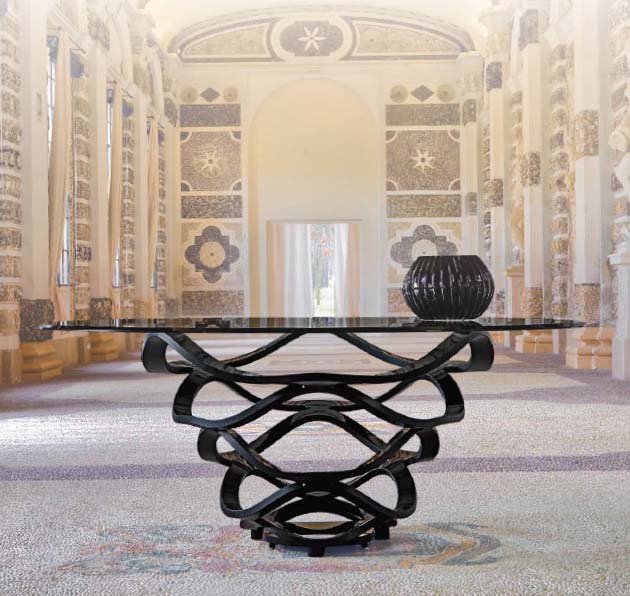
What size for your glass table?
In addition to choosing the shape of your table top, you will wonder what the ideal size would be. We have written an article to guide you in choosing the size of your dining table.
Before purchasing, make sure of the dimensions of your dining room and compare them with the dimensions of the glass dining table you are considering purchasing.
An important consideration is the surrounding furniture and the flow around your glass dining table. Pay close attention to the comings and goings to and from the table, of each of the guests. You don’t want to be too close to a wall or a sofa that would hinder a smooth passage and flow around the table.
Another important aspect is the arrangement of the base under the table. Will it bother your guests? Will you be able to change the table plan of your guests without being constrained by the imperatives caused by the base of the table? Some designs are superb but their creator has not sufficiently considered the practical aspect of the comfort of each guest (room for the feet, space between each guest, etc.).
How much does a glass top weigh?
Glass is not an excessively heavy material especially in comparison to other materials. The weight of your table top will depend on its dimensions and thickness.
Let’s take the example of our HYSTRIX table to see the variation in weight of the glass top depending on the dimensions, the thickness of 15 cm remaining identical.
The rectangular version in 240x120x75h cm has a 15 mm thick glass top and a weight of 100 kg.
The rectangular version in 320x120x75h cm has a 15 mm thick glass top and a weight of 162 kg.
It is also important to consider the weight of the table base as contemporary glass tables often feature complex and heavy legs (either metal or solid wood).
You will therefore need to add 127 kg to the total weight of your Hystrix table to take into account its metal base with the unique design by Giorgio Cattelan.
What thickness should the glass top of your table be?
The thickness of a glass table top will affect its price, style, weight, durability and maintenance.
The thickness of the top will give you an indication of how luxurious and high-end your table is. A luxury glass table should have a certain thickness, our Hystrix table for example has a top with a thickness of 15 mm. The Butterfly glass table model also has a top with a generous thickness of 15 mm, well beyond the recommended thickness of 10 to 12 mm.
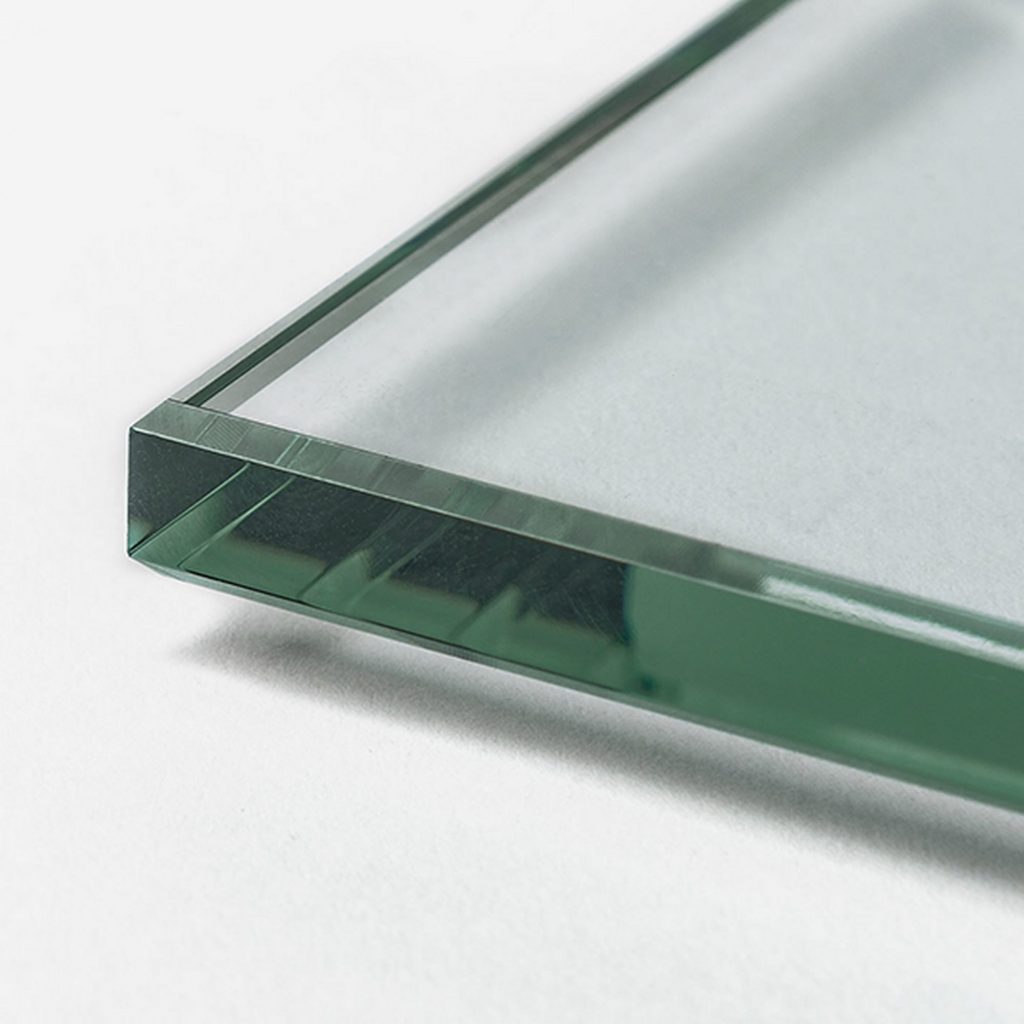
Glass tops of less prestigious tables can be half this thickness, 7 mm.
A thin glass top can give a table a sleeker appearance, but if the top is large (seating more than six people), over the years its weight can cause it to bend. The position of the base support points will also be very important in these conditions.
What base for your glass table?
The appearance of the base will be of capital importance in the aesthetic rendering of your glass table. As the top is transparent, it will highlight the base at all times.
It is important to choose a base that correctly supports the glass top (anchor points), especially if the top is large.
Furniture designers can let their imagination run wild and the result is sometimes stunningly beautiful.
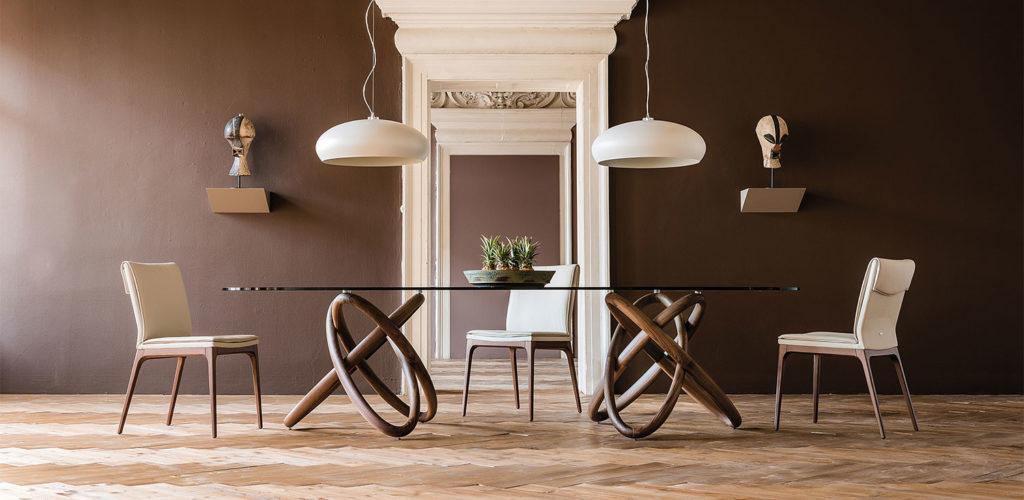
What design for your glass table?
To ensure an original and unique design, do not buy copies or from dealers who sell tables whose designer is not even mentioned, otherwise you will end up with a banal glass table without any character of its own.
There are of course classic style designs as well as more modern and contemporary designs. We have opted for glass tables with a modern and bold design in our collection.
Trust luxury brands that invest heavily to secure the services of renowned and internationally prestigious furniture designers.
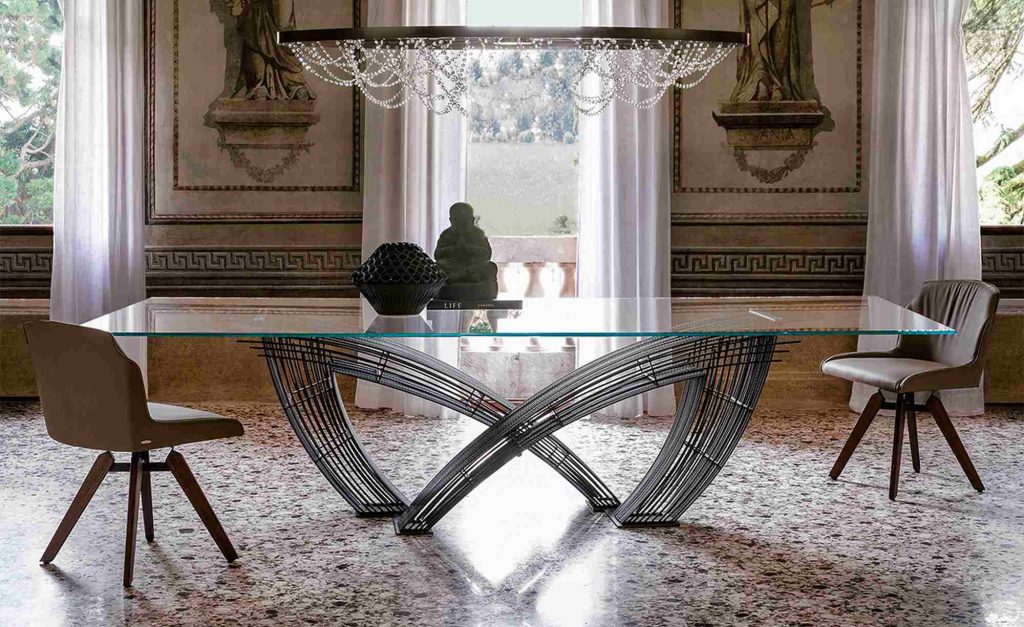

Nucleo+ is a collaboration of artists whose creations have received acclaim from design enthusiasts since the 90s in the furniture and fashion sector. They have imagined the Butterfly glass table .
How much does your high-end glass table cost?
Various elements will have a direct impact on the price of your future table: the thickness of the glass top, its dimensions, the quality of manufacture and the quality of the components (base, anchor points, etc.), the quality of the glass itself, etc.
Here are the reference prices for a luxury glass table made in Italy by a prestigious brand:
HYSTRIX table (glass and metal): from 8,000 to 9,500 euros including tax depending on the dimensions of the top and the finish of the leg.
BUTTERFLY table (glass and metal): from 5,000 to 8,500 euros including tax depending on the dimensions of the top and the finish of the leg.
CARIOCA table (glass and metal): from 5,500 to 12,500 euros including tax depending on the dimensions of the top and the finish of the leg.
Quality, manufacturer reputation
If you are looking for a luxury glass table, special attention should be paid to the reputation of the manufacturer.
Collect information about the experience of people who have previously purchased the same table model.
Note that for a crucial issue like after-sales service, it will depend largely on the reseller rather than the manufacturer itself.
It will be very rare to find a glass table with a manufacturer’s warranty, the ideal would be to insure it if you have a luxury and high-end glass table.
What other styles of furniture will fit in the same space as your glass table?
A successful furnishing project will take into account the ambient universe in your dining room. From the carpet or the floor under your glass table to the furniture and other decorative accessories that will be located near it.
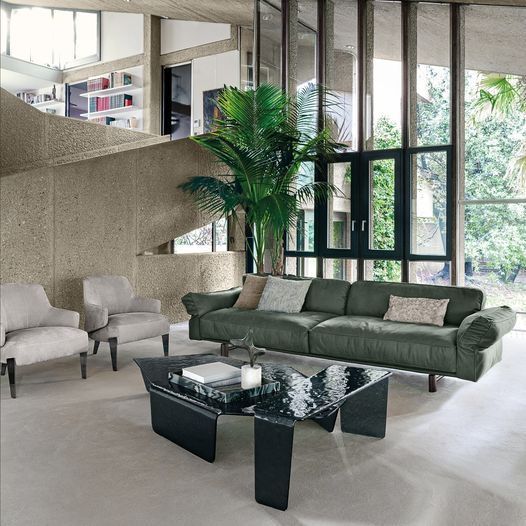
Glass will give complete freedom to the eyes and its transparency will provide a feeling of space while highlighting the other furniture in your living room or dining room. Think about the combination between the base of your table and the other furniture in order to match them or rather to play on the contrasts.
Choosing between a glass table and a crystal table, what’s the difference?
Be careful not to misuse these terms because any crystal table is a glass table but not every glass table is a crystal table. On the internet, these two terms are sometimes used randomly or incorrectly when referring to “glass tables”. The term crystal is often used to refer to a glass furniture or accessory that has a more elegant shape than ordinary, lower-end glass items.
Note that the term “glass” is a generic word that covers different types of glass, including crystal, which is a subcategory of glass and refers, according to the criteria defined by the European Union in 169, to a glass with a lead content greater than 24%, a density greater than 2.90 and a reflection index of 1.545. In the United States, however, any glass containing more than 1% lead is called crystal. The origin of your glass table may therefore have an impact on whether or not you use the term crystal.
A glass top can be made from a variety of materials: silica, sodium carbonate, sodium carbonate, potash, zinc, lead, barium, and titanium. As mentioned below, it is the lead content (above 24%) that allows the correct designation as crystal. It would be correct to refer to glass products containing other metal oxides instead of lead oxide as “crystalline” or “crystalline glass.”
Crystal would absolutely not be suitable for a glass table. Crystal, due to its high lead content, is softer, less malleable and less resistant than glass. This characteristic allows it to be worked in detail with very elaborate designs, engravings and patterns, typical of a piece of jewellery or a work of art. Glass is therefore much more suitable for a product of everyday use such as your dining table.
What are the different types of glass?
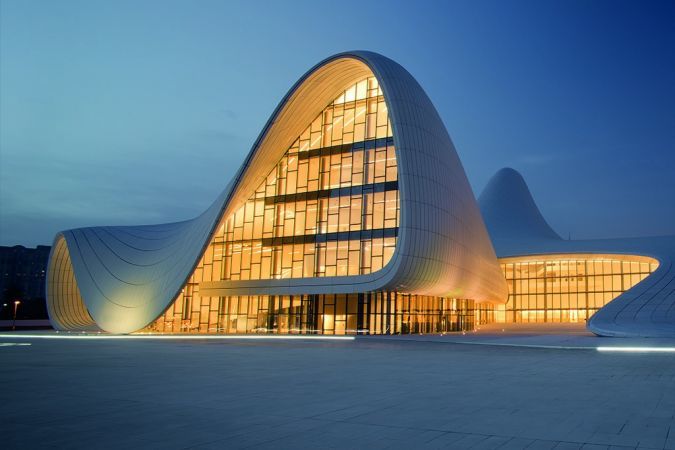
When viewing great architectural works around the world, very often architects resort to the use of glass in order to achieve a captivating and artistic visual effect. Almost all architectural works around the world have a glass component, with this material being present in large proportions and over enormous surfaces.
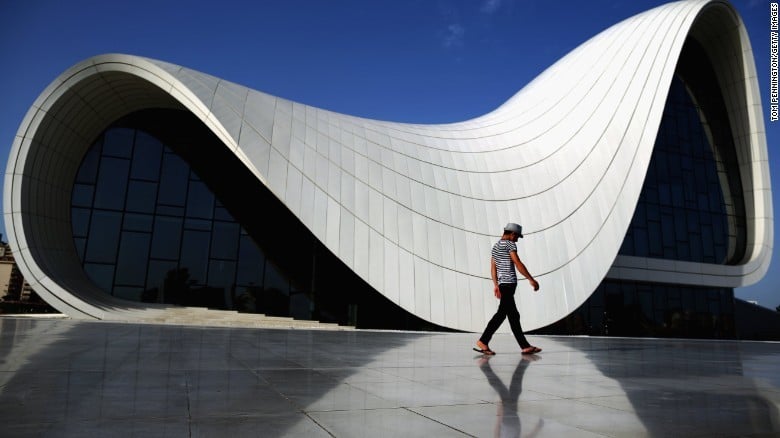
It is of course essential that the glass used, whether in an iconic building or a piece of furniture intended for everyday use, is durable and safe. Heat treatment is a widespread technique for giving glass the essential durability and safety properties.
Heat-tempered glass
A tempered glass table is more resistant to heat, pressure and compression than ordinary glass. It breaks into granules without sharp edges and is relatively safe in the event of breakage.
Tempered glass is often called safety glass (see below). Tempered glass is glass that is reinforced with the aim of improving its mechanical properties (durability, safety).
Able to withstand large temperature variations (up to 200°C), tempered glass also resists bending and significant impacts. When broken, the way in which it fragments, into small, blunt pieces, is essential to ensure the safety of people and property. This is of course a major asset and a crucial aspect for any glass table top.
Tempered glass is made through a process of extreme heating and rapid cooling.
With tempered glass, the cooling process is accelerated to create a higher surface compression (the dimension of force or energy per unit area) and/or edge compression in the glass. It is the air tempering temperature, volume, and other variables that create a surface compression of at least 10,000 pounds per square inch (psi). This is the process that makes the glass four to five times stronger and safer than annealed or untreated glass. As a result, tempered glass is less likely to experience thermal breakage.
Fully tempered glass will have either a minimum surface compression of 69 MPa (10,000 psi) or an edge compression of at least 67 MPa (9,700 psi).
Heat strengthened glass
This glass is obtained by following, initially, the same operations as for the manufacture of tempered glass:
Made using the same production equipment
Heating the glass to approximately 649 degrees Celsius (1,200 degrees Fahrenheit), then forcibly cooling it to create surface and edge compression.
With heat-strengthened glass, the differences in processing with tempered glass are in the cooling process. The cooling process is slower, which means that the compressive strength is lower. Ultimately, heat-strengthened glass is about twice as strong as annealed or untreated glass.
For heat strengthened glass, the requirement is a surface compression of 3,500 to 7,500 psi with no edge compression requirement.
Safety glass
Very often we call tempered glass, safety glass. SECURIT glass is indeed a tempered glass that has undergone heat treatment to strengthen it, but its name comes from its manufacturer, Saint-Gobain. It is indeed a trademark registered in 1929, Securit ®. We can therefore say that a safety glass is a tempered glass, but not all tempered glass is necessarily a safety glass because there are a multitude of different manufacturers.
The use of the term “securit” reflects well the main and sought-after characteristic of all tempered glass, safety, undoubtedly the reason why the two terms “tempered” and “securit” are constantly confused.
Laminated glass
Laminated glass is made of two or more layers of glass that are bonded together with interlayers to form a permanent bond. The interlayers work to support and hold the glass together to create a strong, uniform layer even when broken. Laminated glass comes in different thicknesses and can be created using different combinations of glass or coatings to provide different qualities, such as low emissions or increased insulation.
Laminated glass is therefore the result of an assembly of glass sheets and interlayers (plastic films or in the form of resin). It is the EN ISO 12543 standard that regulates the use of laminated glass in the building and construction sector.
Clear glass

We are in the basic expression of glass, without treatment, it is presented in a raw manner, revealing a slightly green slice, the natural color of the glass.
Extra clear glass
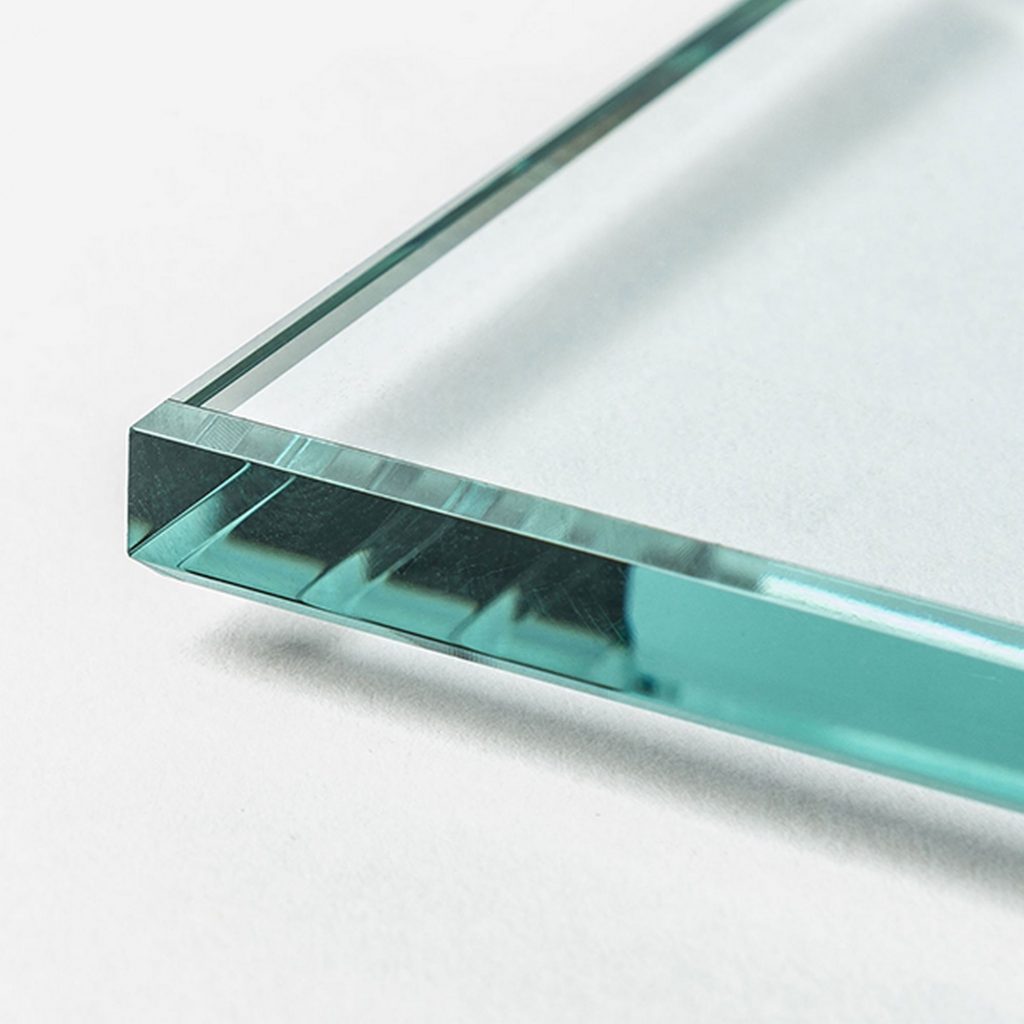
This is a quality above that of clear glass because this glass has been treated to obtain a low iron oxide content and the “green edge” effect no longer appears.
Smoked glass
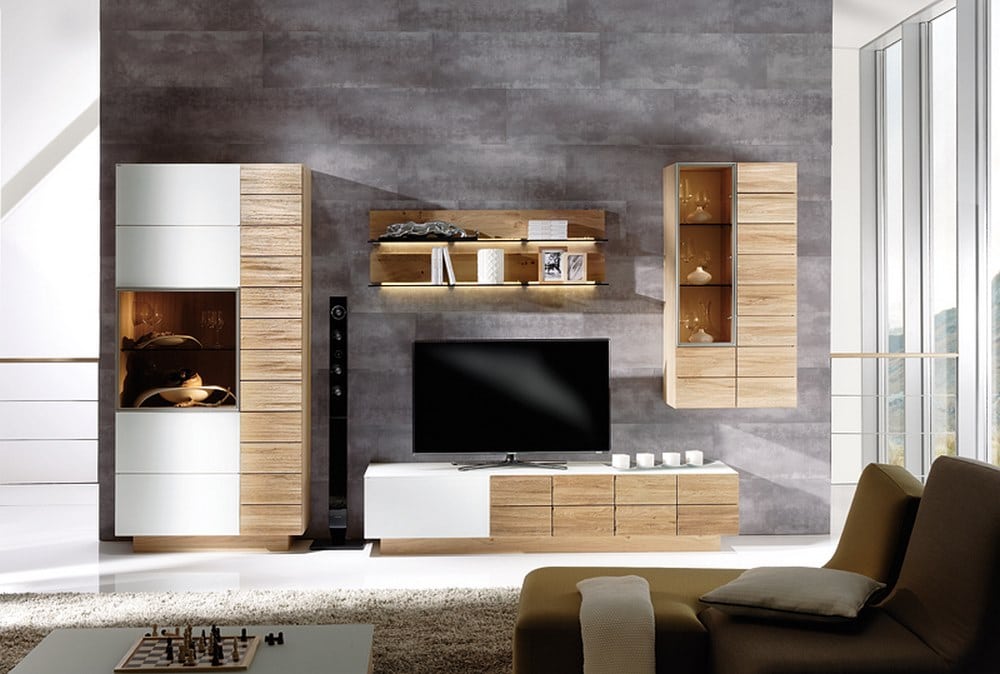
Smoked glass is very often used by furniture designers to give a distinctive visual effect to their creations. The diffusion of light and the opacity of a smoked glass will depend on its thickness.
Smoked glass is a transparent colored glass that is tinted in the mass and which allows to have a colored glass while preserving its properties of transparency with a variable degree of opacity.
Very often in high-end products we observe the use of bronze parsol smoked glass but also gray, azure blue, black or green.
The term Parsol ® is also a Saint-Gobain brand, it is a smoked glass which is a mass-tinted glass which can then be used in the manufacture of laminated glass, tempered glass, screen-printed glass, frosted glass and lacquered glass.
Satin glass
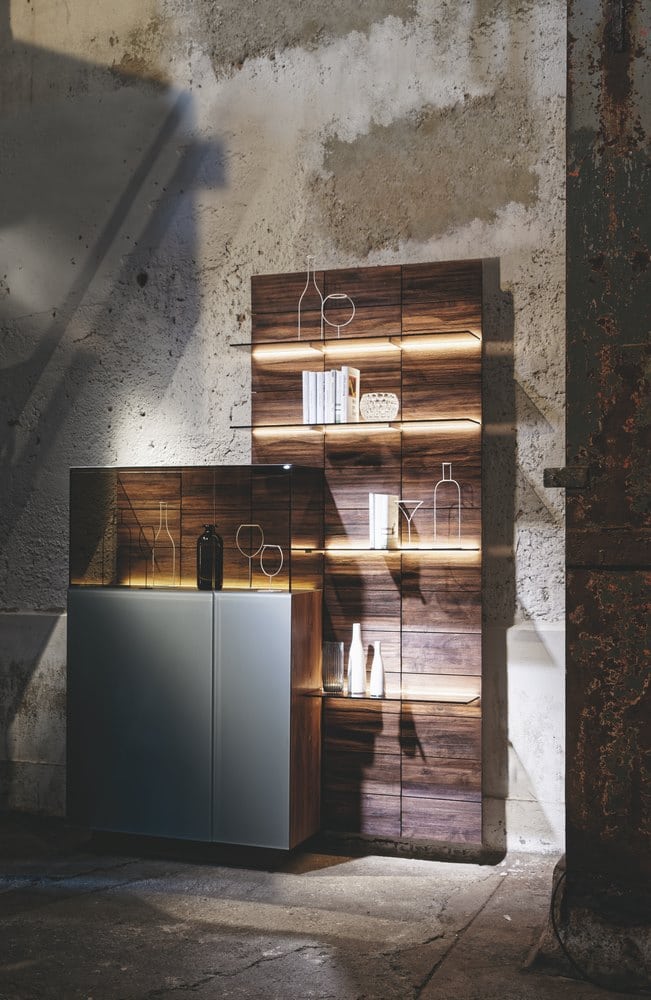
Satin glass is also a type of glass prized by furniture designers. It allows for light variations that produce the most pleasant effects, an artistic and aesthetic advantage over clear or extra-clear glass.
Its translucent and “sandblasted” appearance gives it a very personal identity and enhances the design aspect of a glass table for example. You will also find it on the front or as a top on many other types of furniture: television units, shelves, credenzas and sideboards, etc.
It can be obtained by two different methods:
- a chemical process using chemical projection to create the various irregularities on the surface of the glass.
- sandblasting , allowing the exterior surface of the glass to be hollowed out to give it this unique appearance.
Printed glass
When a glass plate goes into production, it is passed and compressed between two smooth metal rollers. One of the two rollers has a pattern and/or coloring that is embedded on the face of the glass that is in contact with it.
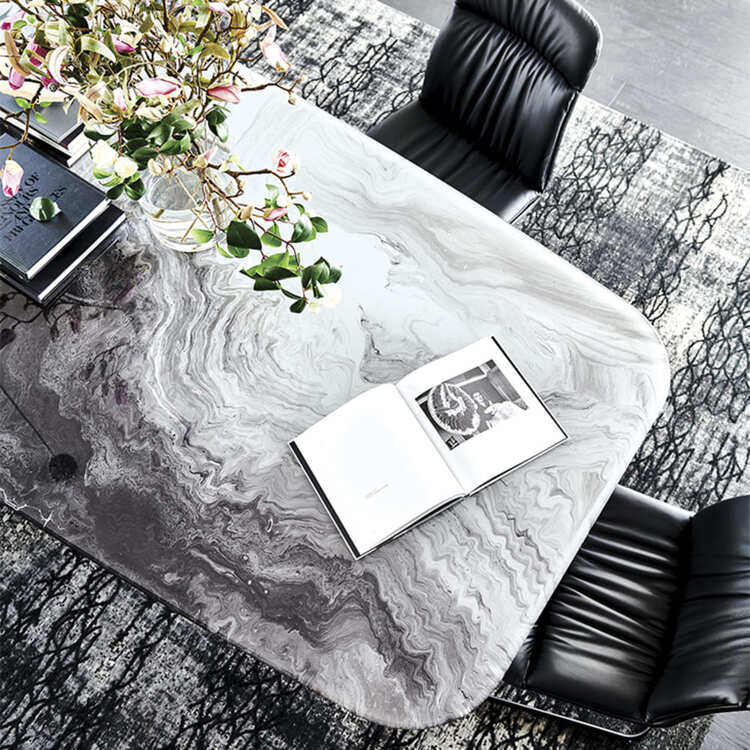
The use of technology to print patterns and colors on glass allows the creation of furniture that is stunning in its beauty. A table with a printed glass top such as Crystalart will give a lively energy and increased brightness to your living room or dining room.
Printed glass lets light in while preserving the privacy sought in an exclusive atmosphere, thanks to its translucent properties.
It is of course essential that your printed glass table top or furniture front is also tempered glass.

